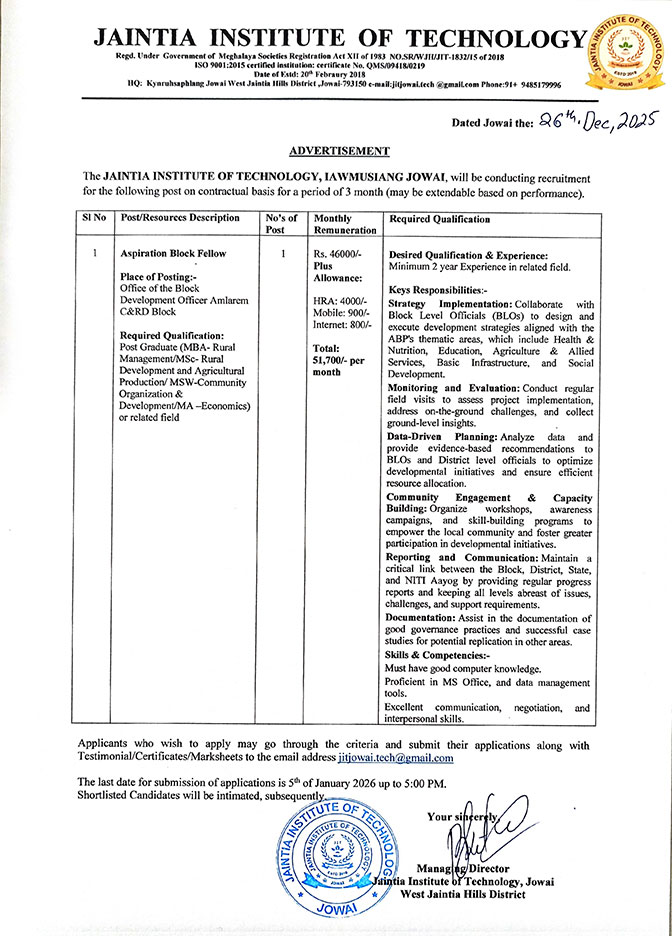
By: Dr. Wa-i-sa Sumer
After Pynsin, the first day of the festival, comes Mulong, the second day. On this day, all the local male members from various localities under the jurisdiction of the Seiñ Raij Jowai begin their preparations. As early as 5 AM, all the religious leaders, under the leadership of U Dolloi, perform a sacred ritual called Knia Aitnar to pay tribute to one of the 14 deities within Raij Jowai—the Guardian Angel. Upon completion of the ritual, all the localities of Kmai Raij, represented by male members, first assemble at Loompyrdi Iongpiah, a designated location situated at the heart of these localities. From there, they proceed towards Biar ka Blai and then continue on to Iawmusiang.
Following this, the men move towards their respective destinations to fetch the Dieñkhlam, the sacred log. This log, a neatly carved tree, had already been examined a few days earlier by male representatives from each locality. Dieñkhlam is not just a log—it is sacred and deeply connected to the significance of the festival. It symbolizes the driving away of diseases, pests and pestilence from the land, invoking protection and well-being for the community. It also represents reverence to Mother Earth and as such, acts of oblation and libation are performed as prayers during the ritual. Moreover, Dieñkhlam defines and reflects the identity of each locality, serving as a proud cultural and spiritual emblem. On this day, the men of the community, accompanied by friends and relatives, carry baskets of food, delicacies, and drinks prepared lovingly by the women of the household—mothers, sisters, and wives. These meals, prepared with care and pride, are packed for the men to enjoy and share with their companions throughout the event. It is not just nourishment, but a heartfelt contribution to the celebration.
Meanwhile, the female members, some dressed in traditional attire, gather at the main market to cheer and support the men as they arrive with the Dieñkhlam. Their bright and colourful presence infuses the occasion with vibrancy and cultural pride. While the male participants bring energy and strength to the celebration, it is the women who bring warmth, motivation, and a deep sense of unity. Their role is indispensable—not only do they prepare food with love, but they also serve as emotional pillars, encouraging the men from their respective localities and proudly upholding tradition.
As the men march toward the forest to fetch the Dieñkhlam, the atmosphere comes alive with the rhythmic sounds of traditional musical instruments like the drum, a woodwind instrument and the Bikur (a trumpet). Only those holding religious responsibilities, along with a few elderly men, dress in traditional attire, marking their spiritual roles within the ritual. The rest participate in coordinated movement and song as they proceed with enthusiasm and purpose. Upon reaching the forest, they retrieve the Dieñkhlam—a freshly cut, polished, and sanctified log—and begin their return journey on foot. It is carried with reverence and collective excitement to an open ground, where it is laid down to rest overnight in an area specially designated for each locality.
Every locality, including Panliar, Dulong, Loompyrdi Iongpiah, Loomïongkjam, Tpep-Pale and Loomkyrwiang—collectively referred to as Kmai Raij—takes part in this vibrant procession, each carrying their own Dieñkhlam log with pride and devotion until it reaches its designated resting place for the night. However, distinct from these is the sacred responsibility of the Khon Raij—a group specially entrusted with divine duties. They are assigned to carry Ka Khnong Blai, the main sacred log, which holds central spiritual significance throughout the festival. This particular log is not merely part of the procession but remains powerful and relevant till the final day of the festival, known as Muchai. The Khon Raij carry this main log towards Loom Soo Iung, where it is respectfully laid to rest for the night, symbolizing its sanctity and central role in the concluding rituals of the celebration.
Tourists and outsiders are warmly welcomed to witness and participate in this grand celebration. They are invited to mingle with locals, don traditional attire if they wish and even join in the dances. Many relish locally brewed rice beer, savour delicious smoked pork and experience the rich cultural heritage of the people firsthand. The festival is a time of spiritual renewal, joyous reunion and heartfelt celebration.
The true highlight of the event lies not only in the grand procession, but in the communal spirit, the music, the dance, and the shared meals. It is a time when old friends reunite, stories are exchanged, laughter fills the air, and the aroma of home-cooked food mixes with the joy of festivity. It is a celebration that captures the essence of community life and harmony.
And with all these vibrant rituals, melodies, and moments of togetherness, the second day of the festival gently comes to a close—paving the way for the next chapter of this sacred celebration.












Discussion about this post